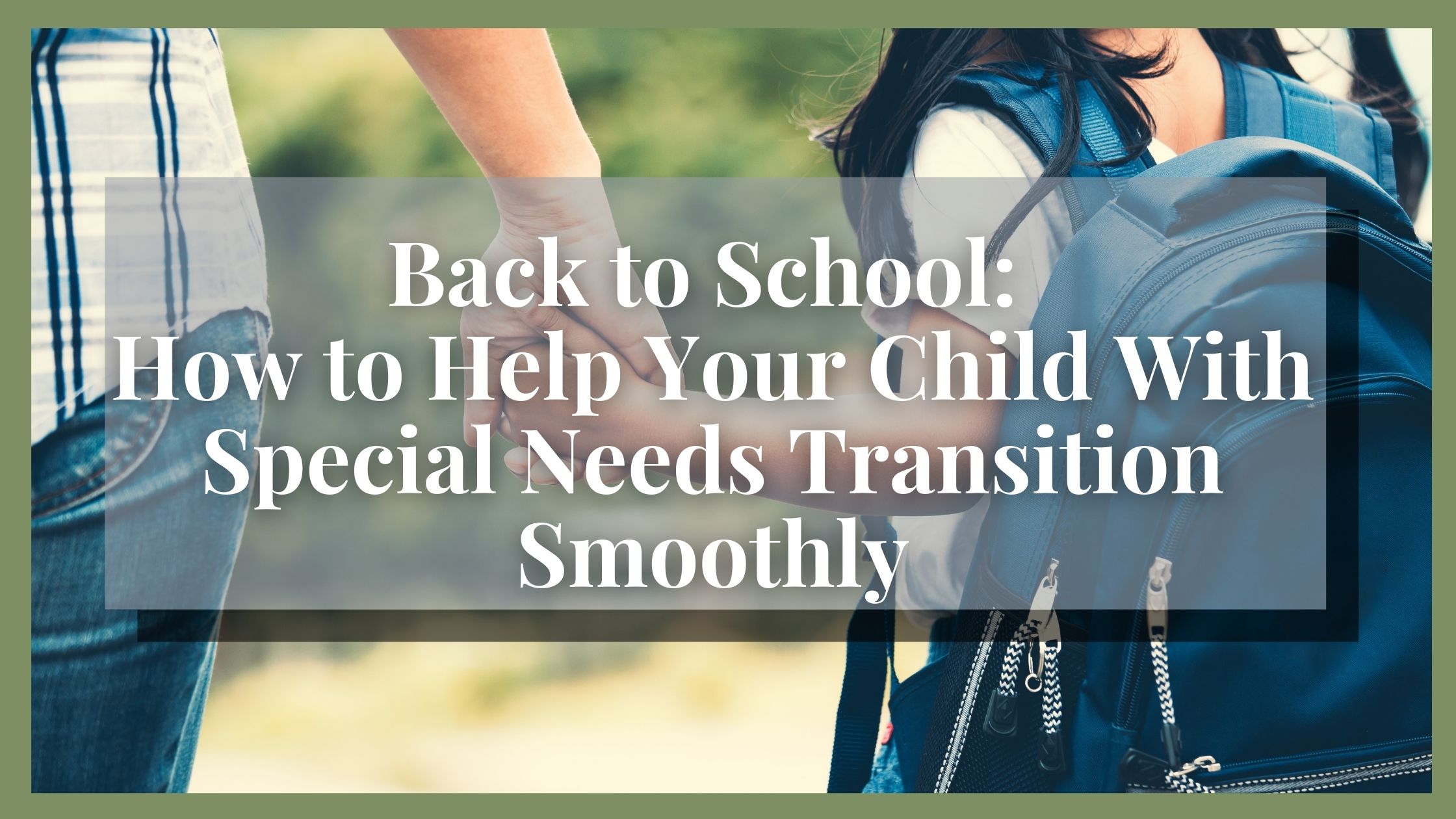Back to School: How to Help Your Child With Special Needs Transition Smoothly
August 16, 2021

For children with special needs, the transition from summer break back to school can be simultaneously exciting and stress-inducing. In the middle of a pandemic no less, and with a new Delta variant of COVID-19 spreading at a rapid rate, going back to school can be uniquely challenging considering many schools are requiring masks upon reopening, along with social distancing procedures to be followed. For many students who are returning to in-person classes now after taking classes online during the pandemic, a learning slide occurred and academic progress may have slowed or come to a halt. Although this can be discouraging to parents who have worked hard alongside their children to track progress and meet goals, it is a completely normal and even expected response to the dramatic changes that have taken place over the past year. Below are a few steps parents of special needs children can take to help their children get back on the right track starting this fall.
-
Understand that re-adjustment to the in-person school setting takes time.
For most students in the U.S, the COVID-19 pandemic meant transitioning from a classroom setting to a completely online one. Others had parents who opted for homeschooling, a popular option for children with special needs or learning difficulties. As a result, many children, both neurotypical and neurodiverse alike, have fallen out of the rhythm of moving from class to class, sitting still and paying attention during lectures, and interacting with peers. Some students with special needs may have completely forgotten the social expectations required of a classroom setting, such as remaining quiet when a teacher is talking, facing forward, and using active listening skills. For many younger children, concepts like sharing, taking turns, and asking nicely may need some brushing up after social distancing. The first step to tackling these adjustments head-on as a parent is understanding that each child will progress and adapt at different rates. There is no use in comparing your child’s social or academic progress to that of another child. Instead, approach obstacles with patience and empathy. During a time riddled with so much uncertainty, what your child needs most from you is stability, clear communication of expectations, and nonjudgmental critique.
-
If your child will have to wear a mask at school, it is highly recommended that you begin wearing masks with your child if you aren’t doing so already.
Depending on how comfortable your child is with wearing a mask, easing into this transition may have to occur sooner rather than later. Baby steps can be made by first discussing masks with your child and why they are important. The free downloadable “Task of the Mask” resource can help with this discussion, and there are many social stories available from Autism Resource Central related to masks, COVID-19, and school. By now, your child has probably seen people wearing masks during the pandemic, but if they haven’t worn one before or haven’t worn one in a long time, it can help to first try them out at home by letting them hold a mask in their hands, smell it or touch it to their face, and eventually attempt to wear one for short periods of time. It should be noted that mask-wearing is best paired with positive stimuli or reinforcement to encourage the behavior, and this can be discussed with your child’s Board Certified Behavioral Analyst (BCBA) as a potential goal to work on during therapy sessions. Demonstrating mask-wearing to your child is also highly beneficial outside of therapy, so the more they see you or their siblings wearing masks, the better. Though it may seem silly wearing masks at home, this can help speed up the normalization process. If they are consistently uncomfortable wearing a mask, see if buying a more comfortable mask helps, like a gaiter or bandana for example. Another great way to include your child in the decision to wear a mask is by letting them choose the design; on websites like Redbubble, for example, there are many masks featuring cartoon characters, superheroes, and funny quotes. Finally, small steps can be made in taking socially-distanced outings with your child, beginning with environments that aren’t overly-stimulating or anxiety-inducing. Trips to the playground, walking around a small town, or visiting cousins are some good examples. If all else fails, schedule a meeting or phone call with an IEP leader at your child’s school to determine if there are ways for your child to take breaks in mask-wearing periodically, or if they are able to leave class early before the bell rings between periods to avoid crowds.
-
In the weeks leading up to the first day of school, slowly begin to incorporate school-related topics into conversation.
The idea of going back to school can be anxiety-inducing for children, so incorporating it lightly into conversation leading up to the first day of school can help your child to re-familiarize themselves with it. A great way to do this is asking about your child’s favorite subjects or mentioning them in a casual way. If your child is doing art or playing outside, for example, you can mention an art teacher or gym class / recess at school. At the grocery store, ask your child if they’d like to bring any specific snacks to lunch. Allowing them to pick out a new lunchbox or backpack unique to their personal style or interests is another great way to encourage a positive outlook surrounding school. The same thing goes with pencil boxes, markers, or any other miscellaneous school supplies; although back-to-school shopping itself might be an activity too anxiety-inducing for your child, don’t be afraid to talk about the use of items like these at a desk or in a classroom setting. If your child needs a notebook or planner for class and has a creative streak, stickers can be a great way to decorate personal items and make them one’s own. The more personalized items are, the less threatening they will be to your child when school finally does start.
-
Begin to incorporate routine back into your child’s schedule.
If your child will have to wake up early every morning for school, have them begin waking up at this time a few weeks prior to school starting, as well as going to bed at an earlier time so they can get a full night’s sleep. They may be resistant or sluggish at first, which is why the earlier this transition takes place, the better. This same concept can be applied to meal times; for example, if you know your child’s lunch period is at 12:30 every day, align this with your lunch schedule at home.
-
Use a calendar to count down the days leading up to school.
Calendars are a great visual resource that can assist in re-familiarizing your child with schedule planning. Once school has started, you can also use a calendar to map out special school events in a given month or class field trips to keep your child informed. This can be especially helpful for children with Autism Spectrum Disorder (ASD).
-
If your child is attending a new school or will be required to travel from class to class starting in the fall, be sure to tour it with them and possibly connect with a peer coach before the semester begins.
New schools are scary for almost everyone, but they can be immensely scarier if they are completely foreign to a child. Even in the case where your child is returning to the same school they attended in a prior year, there is no harm in taking small steps to re-introduce them to the environment. A good way to start is by looking at pictures of the school with them, as well as any maps on the school website. Eventually, you can drive by the school with your child to show them where they will be dropped off each morning, and depending on the nature of the school, you could walk around the campus with them while it isn’t crowded. Virtual tours are sometimes available on school websites, but it is usually best to see things in person considering this is a place your child will be five days out of the week. Finally, you should schedule a formal tour of the school at a time when it isn’t too busy to re-familiarize them with the environment. A faculty member can walk them through their class schedule and might even be able to show them the interior of a classroom, as well as the lunchroom, bathrooms, and staff buildings.
-
Schedule a meeting with your child’s teacher and guidance counselor to discuss your child’s IEP plan.
It is recommended that you schedule a meeting with a guidance counselor or someone who can assist you in re-assessing your child to determine where they can improve academically, and how IEP goals can be adjusted. Because it is natural that they may have fallen behind during the pandemic, re-assessing them in subjects like math and reading can help to give teachers a better idea of how to help and what to spend the most time on. If your child will have multiple teachers in the fall and you are unable to schedule one-on-one meetings, emailing them a copy of the IEP plan and goals is encouraged.
-
The night before school starts, have everything set out and ready to go for the day ahead.
There is no way to guarantee a perfect first day of school, but staying organized by having bags pre-packed, an outfit planned and making a checklist of tasks to complete in the morning can help to make the experience of getting ready more fun. Some children may benefit by having a personal checklist to check off during the day on their own, which can include tasks such as boarding a bus, getting to class, having lunch, and eventually arriving back at home.
https://www.hopebridge.com/
https://hickman-lowder.com/


